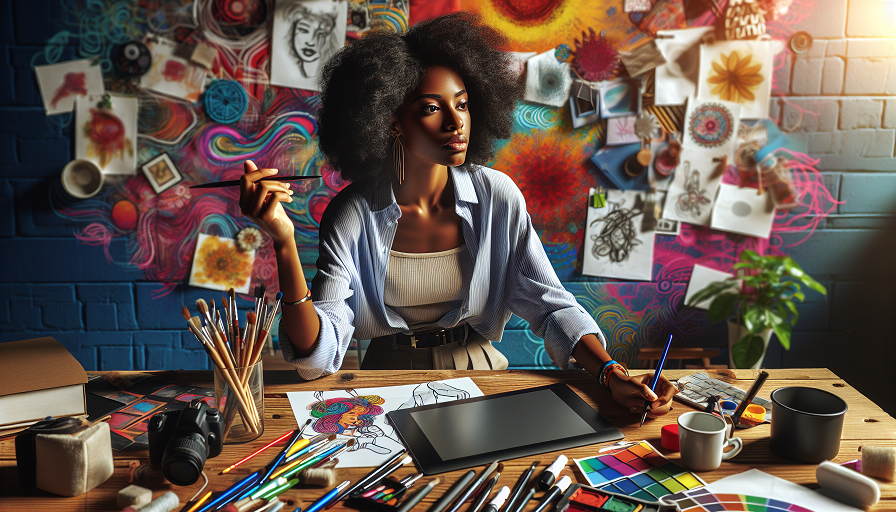
The rise of artificial intelligence (AI) is transforming industries across the globe, and the creative fields are no exception. As AI continues to evolve, it’s reshaping the way creative entrepreneurs approach their work, offering new tools and opportunities, while also presenting unique challenges. For artists, designers, writers, and other creatives, adapting to this changing landscape is essential for staying relevant and competitive.
This article explores how AI is impacting creative entrepreneurship, from enhancing creativity to automating tasks, and provides actionable strategies for leveraging AI in your creative business. By understanding the implications of AI and embracing its potential, creative entrepreneurs can navigate this technological shift and continue to thrive in their respective fields.
Contents
Understanding the Impact of AI on Creative Industries
AI is making significant inroads into creative industries, influencing everything from content creation to design and marketing. Understanding how AI is being integrated into these fields is the first step toward adapting to its influence.
The Role of AI in Content Creation
AI-powered tools are increasingly being used to generate content, from written articles and blog posts to music and visual art. For example, AI writing assistants like GPT-3 can produce coherent text based on prompts, while AI algorithms can compose music or create digital art. While these tools can enhance creativity, they also raise questions about originality, authorship, and the role of human creativity in content production.
AI in Design and Visual Arts
AI is revolutionizing design by automating tasks such as image editing, logo creation, and even entire website designs. Tools like Adobe Sensei use AI to assist designers in generating ideas, optimizing workflows, and refining their work. AI-driven platforms can also analyze design trends and user preferences, providing insights that help creatives tailor their work to meet market demands. However, the increasing use of AI in design also means that creatives need to differentiate their human touch from machine-generated work.
Automating Administrative and Marketing Tasks
Beyond content creation and design, AI is being used to automate various administrative and marketing tasks, freeing up time for creative entrepreneurs to focus on their craft. AI-driven tools can handle everything from scheduling social media posts and managing customer relationships to analyzing data and optimizing marketing campaigns. This automation not only increases efficiency but also allows creatives to scale their businesses more effectively.
Leveraging AI to Enhance Creativity
While AI is often seen as a tool for efficiency, it can also be a powerful ally in the creative process. By integrating AI into your workflow, you can enhance your creativity and explore new possibilities.
Using AI as a Creative Collaborator
Rather than viewing AI as a replacement for human creativity, consider it a collaborator that can inspire and augment your work. AI tools can generate ideas, suggest design elements, or even provide a starting point for a creative project. For instance, an AI-generated piece of music or art can serve as a foundation that you refine and personalize. By collaborating with AI, you can push the boundaries of your creativity and explore concepts you might not have considered on your own.
Exploring AI-Driven Creative Tools
There is a growing ecosystem of AI-driven tools designed specifically for creatives. From platforms that generate custom fonts and color palettes to those that assist with storytelling or music composition, these tools can help you experiment with new techniques and expand your creative repertoire. Take the time to explore different AI tools and see how they can complement your creative process. Whether you’re a graphic designer, writer, or musician, there’s likely an AI tool that can enhance your work.
Balancing AI with Human Creativity
While AI can enhance creativity, it’s important to maintain a balance between machine-driven output and human intuition. AI is excellent at processing data and generating content based on patterns, but it lacks the emotional depth, context, and personal experiences that define human creativity. Use AI to streamline tasks and generate ideas, but ensure that your final work reflects your unique voice, vision, and artistic intent. This balance will help you create work that resonates with your audience and stands out in a world increasingly influenced by AI.
Adapting Your Business Model for the AI Era
The integration of AI into creative fields is prompting many entrepreneurs to rethink their business models. By adapting your business approach, you can capitalize on AI’s potential and future-proof your creative enterprise.
Offering AI-Enhanced Services
As AI becomes more prevalent, consider incorporating AI-enhanced services into your offerings. For example, if you’re a graphic designer, you could offer AI-assisted logo design that combines your creative expertise with AI-generated options. Similarly, writers could provide AI-supported content creation services, where AI generates initial drafts that are then polished and personalized by the human touch. These hybrid services can appeal to clients looking for both efficiency and creativity, giving you a competitive edge in the market.
Creating AI-Based Products
Another approach is to develop products that leverage AI technology. This could include creating digital products like AI-generated art, music, or templates that clients can customize. Alternatively, you could develop software or tools that help other creatives integrate AI into their workflows. By offering AI-based products, you can tap into new revenue streams and position your business as a leader in the intersection of creativity and technology.
Adapting to AI-Driven Market Changes
AI is not just changing how creatives work—it’s also altering market dynamics. As more businesses and individuals use AI to create content and designs, the market may become saturated with AI-generated work. To stand out, creative entrepreneurs will need to emphasize the unique qualities that only human creativity can offer, such as storytelling, emotional connection, and bespoke services. Stay informed about AI trends and continuously adapt your business model to align with market demands while highlighting the value of your human touch.
Ethical Considerations in AI-Creative Collaboration
As AI becomes more integrated into creative processes, it’s important to consider the ethical implications of using this technology. Creative entrepreneurs should be mindful of how AI is used and its impact on the industry.
Ensuring Transparency and Attribution
When using AI-generated content or designs, it’s essential to be transparent with your clients and audience about how AI was involved in the creative process. Clearly attribute the use of AI tools and differentiate between machine-generated and human-created elements. This transparency helps build trust with your audience and ensures that the ethical use of AI is upheld in your work.
Addressing Copyright and Ownership Issues
AI-generated content raises questions about copyright and ownership. Who owns the rights to AI-created work—the creator of the AI, the user, or the AI itself? As a creative entrepreneur, it’s important to understand the legal implications of using AI in your work and to establish clear agreements with clients and collaborators regarding ownership and usage rights. Staying informed about evolving laws and regulations surrounding AI will help you navigate these complex issues.
Balancing Automation with Human Employment
As AI automates more creative tasks, there is a risk of displacing human workers in the industry. Creative entrepreneurs should consider how to balance the efficiency of AI with the need to support human employment. This might involve using AI to complement, rather than replace, human creativity or focusing on offering services that require a high level of human involvement and expertise. By being mindful of the broader impact of AI, you can contribute to a more sustainable and ethical creative industry.
Staying Ahead of the Curve in an AI-Driven World
To thrive as a creative entrepreneur in the age of AI, it’s important to stay ahead of the curve by continuously learning, experimenting, and adapting.
Continuous Learning and Skill Development
The rapid advancement of AI means that new tools and technologies are constantly emerging. To stay competitive, invest in continuous learning and skill development. This could include taking courses on AI and machine learning, experimenting with new AI tools, or attending industry conferences and workshops. By staying informed and expanding your skill set, you can leverage AI to enhance your work and keep your creative business at the forefront of the industry.
Experimenting with AI in Your Creative Process
Don’t be afraid to experiment with AI in your creative process. Try out different AI tools and techniques to see how they can enhance your work, streamline your workflow, or inspire new ideas. Experimentation is key to discovering the potential of AI and finding innovative ways to integrate it into your business. Keep an open mind and be willing to adapt as you explore the possibilities that AI offers.
Building a Community of Like-Minded Creatives
As AI continues to shape the creative landscape, building a community of like-minded creatives can provide support, inspiration, and collaboration opportunities. Join online forums, social media groups, or local meetups where you can share experiences, discuss challenges, and exchange ideas with other creative entrepreneurs. A strong network can help you stay informed about the latest trends, learn from others’ experiences, and find new opportunities to grow your business in the age of AI.

